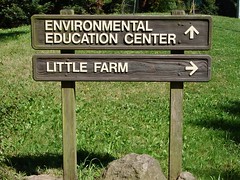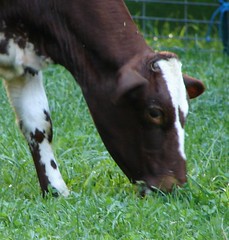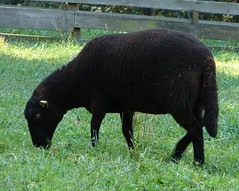Friday, August 12, 2005
Transcribed from my SONY pocket I-C Recorder
Recorded as I walked the Laurel Trail in Tilden Park this morning
Connections are all that matters. I used to think that things and facts in isolation had meaning, but in an age of relativity and the uncertainty principle, as I recognize the importance of stories, narrative, and context, I realize that when you get to the center, there's nothing there. Relationships, how things are tied together, are what matters. An isolated thing is like a point. In geometry, a point has no volume at all. It's location, location, location. Look at a point under an electron microscope, and you find there's nothing there. It's where things come together. (What's the point?)
 Putting things together to establish meaning involves drawing a mental map. Novices are map readers, map adopters, and map learners; they can't find their way without someone else's map.
Putting things together to establish meaning involves drawing a mental map. Novices are map readers, map adopters, and map learners; they can't find their way without someone else's map.
People with experience already have a map in mind. They know their way around. They can pinpoint things on their existing maps, so it's easy to incorporate new features. However, if they encounter something that challenges their map, they're in deep doo-doo because they can't make connections. It's easier to create a framework from scratch than to move an old one aside so you can replace it with a new one. Old frames die hard.
I brought my reading glasses on today's walk in Tilden Park instead of the glasses I wear to see things at a distance, so I'm looking at large shapes, which has probably influenced my thinking about maps and the meaning of the world. The designer of learning environments in the future will be a cartographer as well as an ecologist.
Linguist George Lakoff says we only think in metaphors, and indeed, in what I'll call the New World, what else exists? Senses are important inputs when a baby is creating her first maps, although the baby seems to come with certain ur-maps she inherits from her parents, maps for language or for recognizing wholes (not holes). Without that head start, there's a question if a baby could become human.
 One built-in feature of humans is our drive to explore. The best chart for exploring is one that maps closely to reality (remembering that the map is not the territory).
One built-in feature of humans is our drive to explore. The best chart for exploring is one that maps closely to reality (remembering that the map is not the territory). We pick up pointers from interactions, observations, and a flood of sensory input that we choose, sometimes consciously, sometimes not, to assemble our personal, internal atlases. It's a problem when someone takes in the wrong map, say, the pre-World War I map of Berlin instead of a map that shows the Autobahns and a Reichstag with a giant dome. Much of human conflict comes from people who collide because they are following entirely different maps without realizing it.
If you're following one map, but I plot your path on another, your walking will appear goofy, off the path, and out of it as far as I'm concerned. Making maps explicit will be among the job functions of New World learning cartographers.
The path I'm walking is bordered by bay laurel trees. Their powerful scent reminds me that nature is all about. And the disruption of my thought train sidetracks me into considering whether I may think the way my heart beats. Six months ago I was diagnosed with atrial flutter. (I'm a-okay now.) Your heart probably beats quite regularly: Boom, Boom, Boom. My heart had an electrical short that made it go Boom-ba-ba-ba, Boom-ba-ba-ba, Boom-ba-ba-ba, Boom-ba-ba-ba.... Frankly I think a lot of people are imbued with a Boom, Boom, Boom way of thinking. My thinking is more Boom-ba-ba-ba, with the ba's being mutant ideas that, if amplified, may morph into a whole new rhythm. My mind hops from Boom-Boom big-picture, world-changing concepts directly to ba-ba-ba micro-thoughts like searching for blackberries, without any intervening steps.
Sometimes I'm the last one to take my own advice, even when it comes with my name on it. I've been writing about how important it is to have other people involved in one's learning journey, yet I've been primarily following my own map. So this week I experimented with something I call an online salon. I invite five friends to join me; I throw out a topic, and we have a dialog. Nobody's trying to sell anything, not even ideas. This is more like a group word association test or a visual wiki where we're jointly trying to draw a map.
 I got a lot out of our 30-minute salon. The recording reveals a marvelous tapestry of viewpoints, more than I would have come up with on my lonesome. I'm learning from this and intend to open it up, giving lots of people the opportunity to take part. We'll see how it goes. (Want to join me making some maps?)
I got a lot out of our 30-minute salon. The recording reveals a marvelous tapestry of viewpoints, more than I would have come up with on my lonesome. I'm learning from this and intend to open it up, giving lots of people the opportunity to take part. We'll see how it goes. (Want to join me making some maps?)
With the possible exception of fMRI, we really don't know what goes on inside other people's heads. Consciousness gets in the way. You can never report on your own brain because part of it is inaccessible. You also have this bias about how your brain is so special. A couple of people come to mind:
The fellow who considers his brain the top organ in the body until he reflects, “Who's telling me that?”
Woody Allen cheating on his exam in metaphysics by looking into the soul of the boy sitting next to him.
 We do have some shadows on the wall of the cave, if you will. Stories cast very fuzzy shadows because when we hear a story, we tell ourselves a different story. But if we look at the direct output of someone's work, things come into sharper focus. For example, Jon Udell does what he calls screenshows, which are demonstrations, but unlike most demos which only show the good stuff, never break down, and are probably running on some demo program rather than the real application, Jon walks you through, recording what happens on screen and narrates as he goes along. Jon's presentation style is low-key. He's quite believable. And you see how something is actually done, not a lesson about how it's done. Context comes with the content.
We do have some shadows on the wall of the cave, if you will. Stories cast very fuzzy shadows because when we hear a story, we tell ourselves a different story. But if we look at the direct output of someone's work, things come into sharper focus. For example, Jon Udell does what he calls screenshows, which are demonstrations, but unlike most demos which only show the good stuff, never break down, and are probably running on some demo program rather than the real application, Jon walks you through, recording what happens on screen and narrates as he goes along. Jon's presentation style is low-key. He's quite believable. And you see how something is actually done, not a lesson about how it's done. Context comes with the content.
Stream-of-consciousness is another sort of clue, not very reliable, but at least it shows how ideas in the brain flow and intermingle.
I'm recording this as I walk along a road, it just comes as it comes. And I'm transcribing it verbatim, eliminating the uh's and the huffing and puffing. It would be wonderful if the book chose to write itself in this fashion, sort of one long On The Road-style train of thought. I've read so many books and websites and talked with so many wonderful people about informal learning, I am overflowing with ideas and might be able to dictate a few chapters more or less spontaneously.
Not being distracted by details I can't see I(without my glasses) or recordings of IT Conversations (which I often listen to as I walk) is helping me focus. Sometimes I'm better following one track with a bunch of sidetracks than trying to be a three-track kind of guy.
Yesterday I was reading an account of the first blind person to climb Mt. Everest. When asked if he didn't miss the view from the top, he said, no, the peak experience is on the mountainside, not at the top, for that's where you are and what gets you there. The top doesn't matter.
I'm hardly blind. Or as focused as the climber, but there's a little bit of that, uh, I can't say “keep your eye on the ball,” but the lack of distraction here in the woods, and if I let my mind go wherever it feels like, at least my attention isn't hijacked by some rock-and-roll song playing in the background, if there were one. I'm walking along a beautiful little country road, surrounded by oak trees and poison oak, dry grass, dandelions, and some sort of wild artichoke things, and not much else; I see no buildings. It's delightful. I like it like this.
 When I was twelve years old, I saw my first greased pig contest. Lanky country boys in blue jeans and cowboy boots and white t-shirts, racing around in a field trying to grab hold of a pig that had been rubbed down with baby oil until it was, well, slick as a baby's bottom. Guys would grab the pig; it always got away. There was nothing to hold onto. Anything they grabbed would slip out of their fingers. Maybe this is the same as trying to learn dogma, with things that are presented as certainties and arguments that are supported by faith alone, because like the greased pig, that sort of information doesn't have anything you can grab a-hold of. You can't tie certainties to your own stories, unless you've already bought the whole story yourself, because it's someone else's creation and at best, you'd be able to connect to your version of the story, and if your version is deemed illegitimate, you're not going to make any connections; it will never be yours.
When I was twelve years old, I saw my first greased pig contest. Lanky country boys in blue jeans and cowboy boots and white t-shirts, racing around in a field trying to grab hold of a pig that had been rubbed down with baby oil until it was, well, slick as a baby's bottom. Guys would grab the pig; it always got away. There was nothing to hold onto. Anything they grabbed would slip out of their fingers. Maybe this is the same as trying to learn dogma, with things that are presented as certainties and arguments that are supported by faith alone, because like the greased pig, that sort of information doesn't have anything you can grab a-hold of. You can't tie certainties to your own stories, unless you've already bought the whole story yourself, because it's someone else's creation and at best, you'd be able to connect to your version of the story, and if your version is deemed illegitimate, you're not going to make any connections; it will never be yours.
You can never step in the same stream of consciousness twice. Everything flows.
The rise of the individual over the institution may be a legitimization of other people's maps, recognition that there is more than one viewpoint, and that it may be best to follow several maps; one could be topographical, another political, and another showing nature features. This might make it easier for us to navigate our way to our final destination.
fMRI = Functional Magnetic Resonance Imaging. Brain scanning in real time.
New World is a placeholder until the next era gets a name. A lot of us feel it coming but it's hard to pin down its defining characteristic.










0 Comments:
Post a Comment
<< Home